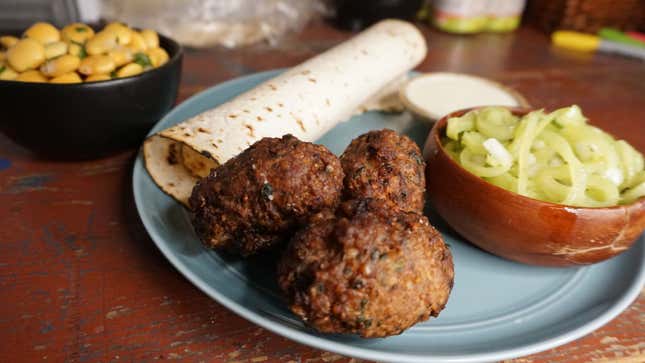
My hometown, New Castle, is a Rust Belt immigrant town in rural Pennsyltucky. The bars there, while sometimes nightmarishly backwards, do serve a surprisingly tasty spread of kibbeh, dolmas, and lamb sandwiches. Syrians, Lebanese, Italians, Greeks, Slovaks—they all came over near the front end of the 20th century to make a living in the burgeoning steel and tin industry.
In regard to culinary acceptance, New Castle is a successful melting pot. Pasta with red sauce, braciole, meatballs, lamb on the rod, and baklava were commonplace at Sunday dinners at my grandma’s house. She also cooked in many of those hometown bars and restaurants, where lamb sandwiches are as common as burgers. Grape leaves grow bountifully before they’re picked in June, then rolled and served in dimly lit holes-in-the-wall. Syrian bread and garlic sauce deftly soak up and mask the smell of hard liquor.
No dish was more omnipresent than kibbeh, though. Kibbeh is the Middle Eastern meatball: lamb, bulgur wheat, mint, and parsley filled with beef, pine nuts, peppers, and onions. It’s like a Cadbury Creme Egg for carnivores: a savory shell hiding spiced meat inside. I remember my grandma frying them up before dinner, placing them on paper towels to extract the grease, then splitting one open to make sure the insides were cooked all the way through, all while I was being healed by the smells of cooked lamb, cumin, and pine nuts. It’s perhaps peculiar bar food given the rural nature of the area, but my grandma helped shape that landscape, and I’m proud of it.
New Castle, Pennsylvania—where you can sit down and order a Yuengling, have some kibbeh, and accidentally start a fight with a guy in a pickup truck. What a town.

Kibbeh
Filling
- 1/2 lb. ground beef
- 1 banana pepper, minced, seeds removed
- 1/2 white onion, chopped
- 1 Tbsp. olive oil
- 1/4 cup toasted pine nuts
- 1/4 cup fresh oregano, chopped
- 1/4 cup fresh mint, chopped
- 1 Tbsp. cumin
- salt + pepper
For the filling, sweat the onion and banana pepper in a pan with olive oil until translucent. Add the ground beef. Cook and chop with a spatula until mostly fine in texture. Turn off the heat. Mix in the mint, oregano, toasted pine nuts, and spices. Cool and set aside.
Outer layer
- 1 pound ground lamb
- 1/2 pound ground beef
- 3/4 cup bulgur wheat
- 1/4 cup fresh parsley, chopped
- 1/4 cup fresh mint, chopped
- 2 Tbsp. cumin
- Salt and pepper
Soak the bulgur wheat in 1 1/2 cups water. Let sit for 30 minutes. The wheat will expand and soak up most of the moisture. Then, drain bulgur wheat well in a mesh sieve and set aside.
Combine the ground lamb and beef into a food processor, running the processor until it becomes a paste. Pulse a few more times, then let it go for another 30 seconds or so. In a bowl, combine the meat mixture, bulgur wheat, herbs, and spices and mix with your hands until well incorporated. This is your outer mixture to form around the interior filling.
To form the kibbeh, take roughly an ice cream scoop’s worth of the outer layer mixture and flatten it out with your hand. Place a few tablespoons of filling inside and form a ball, making sure to seal the filling inside tightly, forming little footballs.
Heat canola or a canola/grapeseed oil mix to about 350 degrees Fahrenheit and fry for 4-5 minutes. As soon as the kibbeh comes out of the oil, hit it with some salt and serve with pepper salad, garlic sauce, lupini beans, etc.
I really like serving them with the following garlic sauce; it mimics a popular style back home.
Garlic Sauce
- 2 egg whites
- 2 cloves garlic
- 1 1/2cups Greek yogurt
- 3-4 Tbsp. olive oil
Crush the two cloves of garlic and puree in a food processor with 1/4 cup of water to form a paste. In the same food processor, add the yogurt and egg white. Blend for another 20 seconds or so. Now slowly add in the olive oil. The consistency should be thin but not drippy. If it feels too garlicky or acidic, feel free to add some more olive oil. The taste should be smooth and tangy.